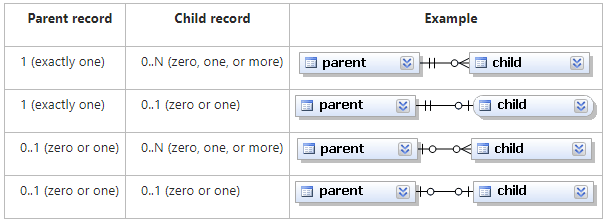Relation Notations
Foreign key relations are displayed as lines connecting tables. Appearance of the relation depends on the selected notation. dbForge Studio supports IE and IDEF1X notations for the diagrams.
IDEF1X Notation
IDEF1X (Integration Definition for Information Modeling) is a modeling language for developing a logical model of data. For detailed description of IDEF1X notation refer to FIPS Publication 184 Announcing the IDEF1X Standard December 1993 by the Computer Systems Laboratory of the National Institute of Standards and Technology (NIST).
Identifying relations are displayed as continuous lines with black circle on the child end. (Identifying relation means when all foreign key columns are included to the primary key of the child table). See example below.

Non-identifying relations are displayed as dotted lines with black circle on the child end. If this relation is an Optional Non-Identifying Relationship (child foreign key columns are nullable), white diamond is displayed on the parent end of the relation. See examples below.


Z letter at the child end of the relationship appears if there can be only zero or one child record. It depends on whether the foreign key columns in the child table are unique (belong to the primary key or unique index). Thus, identifying relations are always displayed with letter Z. Non-identifying relations can be displayed both with or without Z letter.
IE Notation
IE Notation is used by default. Relations are displayed as continuous lines. Ends of the lines depend on relation cardinality. Relation cardinality is determined automatically from the foreign key constraint, it cannot be specified by user (except for editing child table constraints).
In MySQL one record of the child table corresponds to 0..1 (zero or one) or 1 (exactly one) record from the parent table. It depends on the presence of the NOT NULL constraints on the foreign key columns in the child table.
One record of the parent table corresponds to 0..1 (zero or one) or 0..N (zero, one, or more) records from the child table. It depends on whether the foreign key columns in the child table are unique (belong to the primary key or unique index).
